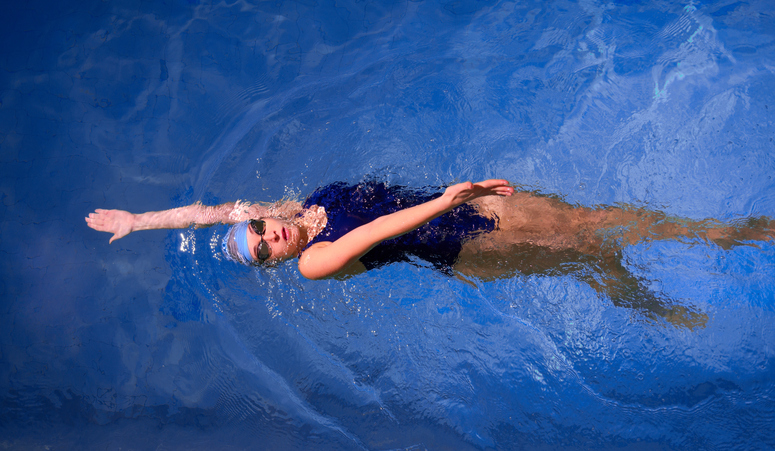How to Swim Backstroke

Swimming backstroke is one of the first strokes every swimmer learns, but it is one of the more challenging-- not because of the movements involved, but because it requires you to swim without seeing where you are going. Learning to swim with that caveat makes this an unpopular stroke, but with our help, you may find it to be the best stroke in your repertoire!
Start by Floating On Your Back
Before you can learn the backstroke, you need to learn and be comfortable floating on your back. To practice this, go into the pool and, with a friend or on your own, turn on your back. Take a deep breath, and point your navel toward the sky. Be comfortable tilting your head back, and spread your arms to your sides. It is a weird feeling at first, but one that you will get used to in time.
Perhaps the hardest part is getting used to your ears under the water. If you are concerned about water getting into your ears, consider buying a swim cap or ear plugs to keep your ears clear.
Keep at this until you are comfortable floating on your back for an extended period of time, and do not get discouraged if you can’t do it right away. Everyone starts somewhere, and it can take time to be used to this strange position.
Practice Kicking
Now that you are comfortable floating on your back, try kicking while you float in the water. Use a flutter kick, that is, one where one leg moves up and the other moves down, to propel you through the water. As you do so, keep your ankles relaxed and your knees slightly bent as you kick. You can do this as fast or as slow as you are comfortable. The faster you kick, the faster you will move in the water, but the quicker you will exhaust yourself as well.
Find a speed that is best for you. Practice kicking and floating at the same time. Again, this will feel weird because you cannot see where you are going, but there is no way around just working through that, unfortunately. If you are concerned about bumping your head, keep one hand outstretched above your head as you swim.
Arm Motions
After you are comfortable kicking, it is time to add in the arm motion. As you kick and move forward in the water, move your arm up in front of you, in a circular motion, until it is pointing toward the sky. Once there, continue the motion and bring the arm past your head, by your ear, and down into the water. This arm will point in the direction you are traveling.
As you bring the arm back down into the water, rotate it so the palm is facing away from you rather than toward you. A good trick to remember is when you arm leaves the water, lead with your thumb. When it re-enters the water, lead with your pinky. This way, your hand will rotate and you will be in good shape to continue the stroke.
Once your arm is under the water, don’t immediately pull with your hand after it enters the water, since this will create resistance. Instead, turn your palm so it is facing the bottom of the pool and scull your hand outwards and downwards until it gets about where your upper chest and shoulders meet. Once there, rotate your hand again so your palm is facing your feet, then push through the water until your arm is fully flexed by the thigh and ready to be lifted out of the water again.
Keep in mind that your arms should move by your shoulders rotating, rather than by moving the arms themselves. It is important to use your shoulders to avoid any unnecessary muscle strain.
Try and keep a steady rhythm as you do this, moving one arm forward and one back. Once you find your rhythm, keep it up! As you continue the stroke, the better you will become at it, and the faster you will swim as well!
Breathing
Last, but not least, you need to consider your breathing. It can be easy to hold your breath while you perform the stroke, but you do not want to do this! A better approach is to breath every time your arm completes a rotation, that way you keep a steady rhythm as you swim. Try taking a breath each time your arm passes your ear. This will keep you in rhythm and swimming faster than ever.
Advanced Techniques
This guide will cover the basics, but if you are interested in learning more advanced techniques regarding the backstroke, look at our guides explaining how to do a backstroke flip turn, a backstroke start and some common backstroke mistakes. Before long, you’ll be swimming like a champ!
